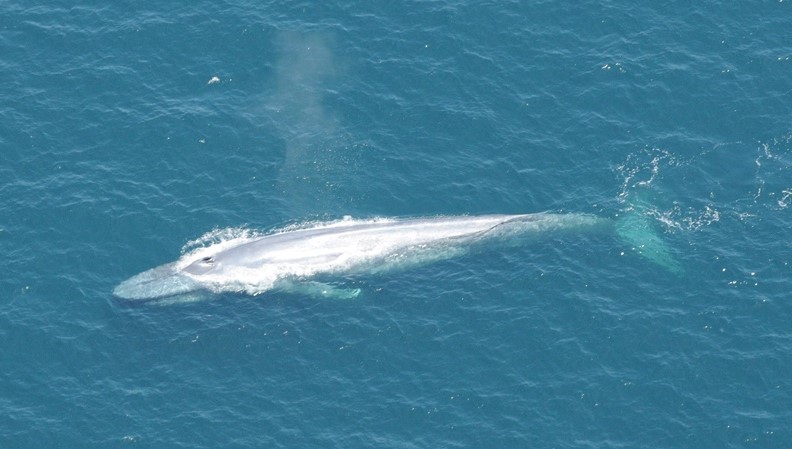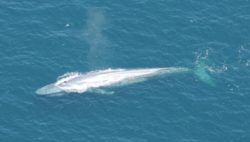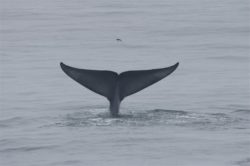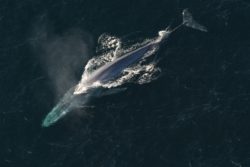
Sea Wonder: Blue Whale

Blue whale in Channel Islands National Marine Sanctuary. Photo: Jess Morten
The largest animals to ever roam the earth aren’t prehistoric dinosaurs, but the blue whale (Balaenoptera musculus). Don’t let their size fool you, though – these giants are quite gentle, swimming slowly and gracefully and feeding on krill, some of the world’s smallest animals.
Description
Blue whales are massive and – you guessed it! – blue (with a little gray mixed in). Their bodies are long and slender, and each whale has a unique marbling pattern of their skin, which scientists and observers can use to tell whales apart. When fully grown, blue whales can reach lengths of 70 to nearly 90 feet and weigh as much as 300,000 pounds. They are rorqual whales, a group of large whale species known for their pleated, expandable throat skin that assists them during feeding. Inside of their mouths are plates of baleen, sheets of keratin that allow them to filter food out of sea water, and atop their heads are two blowholes used for breathing. Their dorsal fins are quite small for their body size and their pectoral flippers are long and thin. Sometimes, they will develop patchy algal growth on their backs due to their slow movements. Their bellies are lighter than their backs and have a yellow tinge from the food they eat, earning them the nickname “sulfur bottom.”
Diet & Habitat
Blue whales, being the size they are, need a lot of food to give them the energy they need to survive and to build their thick blubber layers to keep them warm in the ocean’s cold waters. Their food of choice are krill – small, shrimp-like crustaceans that swim in massive swarms – though their gulping feeding strategy doesn’t allow them to be picky. Sometimes fish, copepods, and other small animals will get caught up in the mix and be eaten by the whales. When food is plentiful, blue whales can eat between four and eight tons of krill per day, or upwards of 40 million individual krill. Thankfully, their throats expand to accommodate all that food! Due to their size, blue whales are not often preyed upon, though pods of marine mammal eating orca whales will sometimes attack and share younger blue whales.

Blue whale flukes spotted in Channel Islands National Marine Sanctuary. Photo: Josh Kaye-Carr/ NOAA/NOS/NMS/CINMS; National Marine Sanctuaries Media Library
Blue whales live in nearly all corners of the world’s ocean except for the Arctic. Since krill tend to gather in the open ocean, you can generally expect to find blue whales farther from the coasts and in waters deeper than 650 feet in search of them. In the National Marine Sanctuary System, blue whales are commonly seen near Stellwagen Bank, Olympic Coast, Greater Farallones, Monterey Bay, Cordell Bank, and Channel Islands national marine sanctuaries, but they may travel past or through all of the oceanic sites in the System (sorry freshwater sanctuaries!).
They usually migrate twice each year, spending their summers in cooler waters where food is abundant and their winters in warmer waters where they mate and give birth. Despite their massive size, blue whale migrations are hard to keep track of, so we don’t yet know much about specific migratory routes.
Life History
Blue whales spend much of their lives alone but do frequently form pair bonds or gather in small groups, especially when they are in their winter breeding grounds. Blue whale pregnancies last 10 to 12 months and each female will give birth to a new calf every two or three years. Each calf is born at around 26 feet long and more than four tons in weight! Calves rely on milk they nurse from their mothers for the first year of their lives, and for the first few months will gain weight at a rate of 250 pounds per day. As the whales migrate from winter breeding grounds to summer feeding grounds, calves practice hunting and eating solid foods. Calves leave their mothers when they give birth to their next calf, and will reach maturity when they reach their full size, between five and 15 years of age. Blue whales may have a maximum lifespan upwards of 110 years old.
Like other whale and dolphin species, blue whales communicate with vocals and nonverbal body language. To produce calls to other whales, they push air through specialized air sacs near their blowholes. Body language may include swimming in a synchronous pattern, slapping their pectoral or tail fins on the surface of the water, or jumping out of the water and landing on their sides, a behavior known as breaching.
Threats & Conservation
Blue whales are an endangered species recognized by the International Union for the Conservation of Nature (IUCN) Red List and the U.S. Endangered Species Act. They also receive protections under the U.S. Marine Mammal Protection Act of 1972. Due to their massive size and slow movement, blue whales were a desirable species to hunt for their blubber. Commercial whaling of this species peaked in 1931, and in 1966 the International Whaling Commission declared them a protected species worldwide. Thankfully, their populations have recovered in the decades since, though other threats put the species at risk of decline. These threats include vessel strikes, entanglement, ocean noise, overfishing of their prey, and climate change impacts.

Blue Whale. Photo: NOAA
